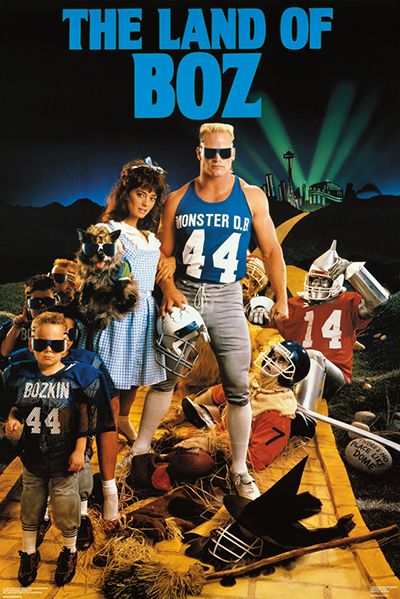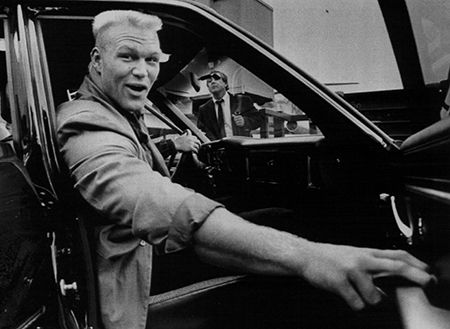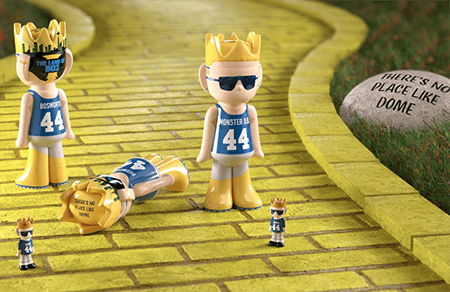“Can we mohawk the dog?”
It was a totally outrageous question, but one perfectly befitting a totally outrageous time.
It was 1987, and John Costacos was staring out at the set of the photoshoot for his company’s latest poster, which looked like “The Wizard of Oz” on some sort of acid dream.

There was a makeshift yellow-brick road, leading to the green lights of the Emerald City of Seattle and littered with a broom, witch hat and football helmets.
There were two radio disc jockeys dressed up as the Scarecrow and Tin Man in football uniforms, with one unmistakably wearing John Elway’s orange No. 7 jersey.
There was the Cowardly Lion, popping out of a hole in those yellow bricks and donning a red helmet of his own.
There were three young boys in blue football jerseys — one who refused to look at the camera and another who kept picking his nose — all sporting “Terminator”-style sunglasses and carefully crafted mohawk haircuts with blue and white stripes on the side.
There was a former Playboy Playmate dressed as Dorothy, complete with ruby red slippers and a blue bow in her hair.
And there was a little dog in Dorothy’s arms, wearing those same wraparound sunglasses and sporting … yes, a mohawk.
All that was missing was the star. So Costacos picked up a phone and called the agent who represented Brian Keith Bosworth.
You might know him better as “The Boz,” the rebellious antihero who was a two-time Butkus Award winner as one of the best linebackers in college football history at the University of Oklahoma.
He had just been drafted by the Seattle Seahawks with the first pick in the 1987 NFL Supplemental Draft, and he was headed to the Pacific Northwest with much fanfare.
But now, he was late.
Although Bosworth insists to this day he was running behind because he was in a team meeting, the stereotypical superstar tardiness perfectly fit the character of The Boz.
It was exactly what the creative minds at Costacos Brothers wanted: An oversized personality who just as many fans hated as loved.
“I call them antiheroes,” Costacos told cllct of the type of characters his company immortalized on posters that decorated the walls of teenagers throughout the 1980s
“They're heroes to their city and villains to the other cities. You know, it’s Jim McMahon, Lester Hayes, Charles Barkley, Brian. Those kinds of guys are bigger than life.”

While Costacos and his brother, Constantine, were creating posters that felt like real-life comic book covers, their work from 1986-96 lives on today as a testament to the time. There was even an exhibit in New York in the early 2000s featuring their posters, and Costacos says UFC president Dana White showed up and bought 37 of them for $2,500 apiece.
“We just made posters for kids,” Costacos said. “Now, they’re considered art.”
More than 100 of the poster subjects ended up in the halls of fame for their respective sports, but “The Land of Boz” poster, the 10th ever produced by the company, likely stands as the most memorable final product and easily the most sophisticated photoshoot.
The poster will get a second life Tuesday, when ghostwrite releases 100 limited-edition “Land of Boz” ghost collectibles. The drop will feature an 11-inch Bosworth ghost figurine and a mini “Bozkin" ghost, both featuring that bold hairstyle choice.
While the ghosts are bringing “The Land of Boz” into 2025, the original could have only been born in the 1980s.
“As I look back on it, it just drips with the sensational decade of the ‘80s,” Bosworth told cllct.
“Everybody was just living on the edge and living for fun and just being their best versions of themselves, regardless of how outrageous they were, because you didn't really need permission. We just did it because it felt good. We were really just following our own self-imposed energy.”
Costacos, whose Seattle-based company produced posters of legends such as Walter Payton, Joe Montana, Michael Jordan, Larry Bird, Magic Johnson and Ken Griffey Jr., built its reputation around putting athletes in unique costumes and elaborate situations.
And the creators went deep in their process to always find the right name or hook for each piece.
“What rhymes with his name? What’s his number? What are his initials? Any acronym?” Costacos recalled when going through the elements of how the company approached its themes.
As athletes such as Deion Sanders, Bo Jackson and Jim McMahon built their own marketing brands in the ‘80s, they became natural targets to end up in a Costacos print.
Few players ever fit that target mold better than The Boz.

He already came with the built-in name, flashy persona and on-field success that had caught Costacos’ eye dating back to Bosworth’s freshman season at Oklahoma. When The Boz appeared on the cover of Sports Illustrated’s 1986 football preview with McMahon on his shoulders, Costacos knew he had to work with the loud linebacker.
“(When) we found out that he was leaving Oklahoma to go to the NFL, we couldn't believe how lucky we were that he ended up in Seattle,” said Costacos, whose company was based in the Pacific Northwest.
Unsure how to get in contact with Bosworth, Costacos said he sent a letter to the Oklahoma athletic department, which got a message to the player’s agent, Gary Wichard, whom Bosworth said was responsible for the creation of The Boz character and all his off-field marketing.
While Costacos was thrilled by the good fortune of having The Boz come to his neighborhood, neither Bosworth nor Wichard were initially thrilled with the idea.
“Where’s Washington?” Bosworth said of his reaction when hearing the Seahawks had won the No. 1 pick of the supplemental draft. “I’m thinking Washington on the East Coast, not the state (of) Washington.”
Bosworth was hoping for New York or Los Angeles, especially the Raiders, who fit his rebellious style. Tampa Bay was also a rumored possibility as Bosworth’s camp had heard Bucs owner Hugh Culverhouse was trying to make moves to get that top pick.
“Seattle pulls the chip out, and I was in New York at the time. I’m just scratching my head,” Bosworth said. “Seattle — that came out of nowhere.”

Bosworth said Wichard came up with the idea to tell the media the linebacker wouldn’t play for Seattle, which “didn’t sit right with a lot of people.”
"Now, had I had a little bit more thought and control and understanding of the good and the bad of making decisions like that, I'd probably go back to my younger self and just kick him in the balls and say, ‘Hey, look, just do it the right way,’” Bosworth said.
“Humility and going in the right way is gonna end up being a lot better for you than going in the way you did go in, because you really did put a bull’s-eye on my back, and it created a lot of negative controversy around me.”
While Bosworth said Wichard — who was an inspiration for Cameron Crowe’s 1996 movie “Jerry Maguire” — was pushing him to appear on talk shows and consider a career in Hollywood, he wanted to dial things back.
“I always kind of maintained The Boz was kind of an alter-ego of Brian Bosworth, but I kind of wanted to keep the Boz on the field. Gary really wanted The Boz to drift off the field at times,” said Bosworth, who did star in the 1991 movie “Stone Cold” and made a cameo in “The Longest Yard” remake in 2005. Younger fans might know him from a recurring role as the “Sheriff of Fansville” in Dr. Pepper’s long-running commercial campaign.
Costacos knew he definitely did not want The Boz “on the field,” and so he let his imagination run wild with the possibilities for the poster.
He kept coming back to the concept of the Emerald City.

So, he enlisted designer Mike Dillon of Dillon Works, who had built rides for Disneyland, to construct the detailed set.
He sent out a casting call for the role of Dorothy before finally landing model Ava Fabian, which helped create headlines.
He got his favorite radio personalities, Gary Crowe and Mike West of Seattle’s KXRX 96.5 FM, to put on costumes.
And he enlisted some of his friends’ children to play the role of the “Bozkins.”
“When John came up with the poster idea, I said it just naturally fits. You're the Emerald City. Everybody is fascinated with the Wizard of Oz. So the Wizard of Boz is fantastic,” Bosworth said.
“Let’s do everything as outrageous as possible.”
That outrageousness included bringing Bosworth’s hairdresser to the set to make sure everyone had the proper Boz hair — which Bosworth says requires “a certain set of special skills” and is absolutely “not a mullet.”
Even the poster’s version of Toto got the cut.
“Brian and I would probably be in jail if we did that today,” Costacos said. “But we said, ‘OK, let's mohawk the dog.’ He painted his hair blue, and so there we are.”

Where we are now, nearly four decades later, is with the “Land of Boz” poster getting a second life through the collaboration with ghostwrite.
Josh Luber, founder and CEO of ghostwrite, said he came up with the idea to make the “Land of Boz” ghost one night when he was moving papers around in his office and saw the poster on the cover of a Costacos Brothers coffee table book.
It took him back to having that poster on his walls as a teenager, and Luber says the company would love to create collectible ghosts for other Costacos posters.
“But there's a reason we chose this one first, right?” Luber said. “Everything about Boz and everything else. … Everyone on that (poster) is iconic.”
The collectible ghost sets of The Boz and his Bozkins are now available for bidding via Dutch Auction at ghostwrite..
Kevin Jackson is the chief content officer for cllct. He spent 25 years at ESPN Digital Media, where he was the founding editor of Page 2, and nearly four years as the Executive Director for Digital Content at FOX Sports.

